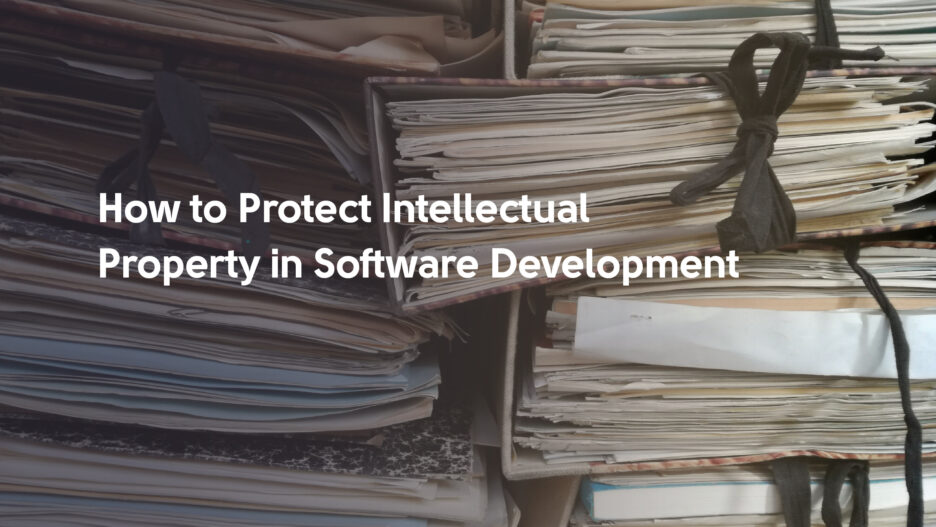The software development industry is always brimming with innovation and creativity. Developers always push the boundaries from modern mobile apps to complex enterprise solutions to develop solutions that shape the digital future.
In parallel, as software development expands, the need to protect intellectual property (IP) takes greater significance.
This article will explore how to protect intellectual property in software development and its importance.
What is Software Intellectual Property?
Let's define the concept before delving into the nuances of protecting intellectual property in software development.
Software intellectual property refers to the legal rights and protections granted to the creators or owners of software-based creations. These rights safeguard a software product's unique and original aspects, including its source code, algorithms, user interfaces, and underlying concepts and ideas.
Software intellectual property presents itself in several forms, the most common of which are:
- Copyright: Copyrights apply to original software code and ensure creators have exclusive rights to reproduce, distribute, and modify their work.
- Trademarks: Trademarks protect a software product's branding, logos, and names.
- Patents: In some scenarios, software solutions are eligible for patent protection, mainly if they deal with new processes or algorithms.
- Trade secrets: Proprietary algorithms or confidential processes can be trade secrets, requiring strict confidentiality measures.
Now, let’s explore each one in more detail.
Understanding Copyright
A copyright gives creators exclusive rights to their original work, preventing others from copying, distributing, or using it without explicit consent.
Whether it’s a creative expression, like software code, user interfaces, or the software structure, copyrights safeguard the unique elements of your software. Copyright protection applies as soon as the work is created and available in a tangible medium, meaning you don’t have to register it to have a specific level of protection.
Protecting your copyrights ensures that your unique code and other creative elements remain yours. It also gives you a legal basis to act against those who infringe on your rights by using the software without your permission. Additionally, it acts as a deterrent against unauthorized use, distribution, or copying.
As stated earlier, copyright protection is automatic once you create your software. However, registering it with the United States Copyright Office (or the relevant authority in your country) allows you to have concrete evidence of your ownership. It can strengthen your position if you ever need to take legal action.
You should include a copyright notice in your software’s documentation or interface to indicate your ownership. Typically, copyright protection is active during the creator's lifetime plus 70 years, but this can vary.
Understanding Trademarks
Words, phrases, designs, symbols, or combinations can constitute a trademark. Essentially, it’s any recognizable element of your company in the marketplace. In software development, trademarks can be interchangeably used with service marks, but trademarks are the umbrella terminology that also encompasses tangible products, while service marks protect services.
Trademarks help your customers identify the source of your software, boosting trust and brand loyalty. Additionally, by registering your trademark, you have the legal protection of your brand’s identity and can act as a shield against counterfeiting and fraud.
Holding a trademark doesn’t necessarily mean having exclusive rights to a particular word or phrase. Instead, it grants you rights over how that word or phrase is used in the specific context of your goods or services.
So, when do trademark rights begin? They are established as soon as you begin to use the mark with your goods and services, or in this case, your software. This “common law” trademark protection applies to the region where you provide your software. For example, to secure nationwide protection in the US, you need to apply for registration with the United States Patent and Trademark Office. Remember that trademarks are valid only in the country where they are granted. For international protection, you must file an application in each country you want.
Understanding Patents
Patents are government-granted exclusive rights to build, sell, and use your software invention, preventing others from doing so. To get a patent, you must disclose every detail of your creation to the public, opening the door for other parties to replicate it. In a way, patents encourage innovation by sharing knowledge, but they also encourage copycats.
To secure a patent of your software innovation, you must make sure it meets these requirements:
- The patentable software invention must fall within the categories defined by each country’s authorities.
- The software must be new and not in existence.
- The software needs to have a practical use.
- The software can’t be obvious to someone skilled in the field.
In software development, there are two patent types, each one catering to different areas.
- Utility patent: Granted to developers of new processes or compositions; they typically last 20 years.
- Design patent: Granted to new and original software designs, specifically safeguarding visual aspects of the software; they are typically valid for 14 years.
Worth mentioning patents come with a hefty price tag. Usually, maintaining a patent requires paying regular fees. Additionally, patent protection is geography-based, meaning it’s only valid in the country it was granted.
Understanding Trade Secrets
Trade secrets protect confidential information that helps maintain a competitive advantage. But what truly constitutes a trade secret? The essential traits of a trade secret include:
- Secrecy (information not made available to the public),
- Confidentiality (information that is kept confidential, even from internal parties),
- Economic value (the data gives an economic advantage to the holder by remaining unknown to other parties).
Why Protecting Intellectual Property Matters in the Context of Software Development
When companies decide to outsource, it becomes even more apparent why securing intellectual property in software development becomes crucial. Having other parties, like vendors, developers, or contractors, working on your software exposes valuable intellectual property
This augmented exposure makes it necessary to deploy robust protection mechanisms. Why? Let’s review:
- Maintaining a competitive advantage: prevent competitors from copying or replicating your software solutions.
- Securing your investments: Intellectual property in software development can make your company more attractive to investors and potential partners.
- Enforcing legal safeguards: In the event of disputes or breaches of contract with outsourcing partners, having well-defined intellectual property protections in place can help you enforce your rights and seek legal remedies.
- Boosting innovation: Intellectual property protects current software assets and incentivizes developers to create even more innovations.
Securing Intellectual Property in Software Development
Now that we have a greater understanding of the different types of intellectual property and the importance of their safekeeping, we must address how to implement a robust strategy throughout your software development lifecycle. Next, we explore some of the most prominent and proven methods for implementation.
1. Intellectual Property Software Development Agreements
Start by establishing detailed intellectual property software development agreements with your outsourcing partner. The scope of work must be clearly defined, as well as the ownership rights and any confidentiality obligations. It’s recommended that you make sure all parties understand their roles and responsibilities regarding intellectual property.
2. Non-Disclosure Agreements (NDAs)
Next, it’s best practice to ensure that every individual involved in the software development project, including UI/UX designers, engineers, project managers, testers, and more, sign non-disclosure agreements to bind them to confidentiality legally. This agreement prevents any party from sharing or using your proprietary information outside the scope of the work.
3. Define Ownership and Licensing
Specifying ownership is another best practice for securing intellectual property rights in your agreements. From the get-go, determine if all the software and its components will belong to you, the company, or the vendor or if there will be shared ownership.
4. Code Escrow Services
Implement code escrow arrangements so the escrow service can release the source code to your company in case of any dispute, ensuring you have access to your software assets.
5. Regular Code Audits
Conduct regular code audits to monitor your software development process and ensure that your intellectual property is handled according to the established agreements.
6. Access Control and Security
Limit access to only the team members who require it. Implement stringent security measures to protect against unauthorized access, data breaches, and cyber threats.
7. Encryption and Secure Communication
Encrypt communication channels to protect intellectual property and sensitive information with outsourcing partners.
8. Track and Document Changes
Document software development processes, including code revamps, updates, and revisions, to prove code ownership and the process itself.
9. Monitor Compliance
Monitor the vendor’s compliance with the agreement by ensuring they adhere to the stipulated property protection protocols.
10. Post-Development IP Transfer
Ensure all software rights are transferred upon project completion as your agreement stipulates. This covers source code, related assets, documentation, visualizations, and more.
Ready to Outsource? Ensure Your Intellectual Property's Safety with Svitla Systems
Throughout this article, we’ve highlighted the critical steps and mechanisms you can employ to secure your software IP when collaborating with outsourcing partners. From well-defined contracts and non-disclosure agreements to diligent code audits and secure communication practices, these strategies protect against IP risks.
Innovation is the lifeblood of any software development project’s success. Svitla Systems has a proven track record of 20+ years of delivering top-tier software solutions while understanding the significance of intellectual property in the context of our outsourcing services.
The integrity of our client’s solutions and innovation is our priority.
Our experienced teams are well-versed in adhering to the highest standards of confidentiality and compliance, providing you with peace of mind as you embark on your outsourcing journey.
As you venture into outsourcing software development, remember that preserving your intellectual property is not merely a legal requirement but a strategic imperative. Navigate outsourcing with trusted partners like Svitla Systems, knowing your software innovations are safe and protected.





